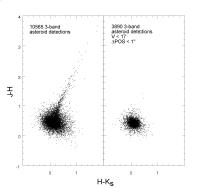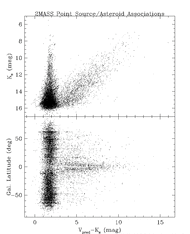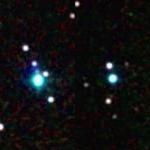IV. 2MASS Data Processing
9. Known Asteroid, Comet, Planet, and Satellite Associations
The 2MASS Point Source Catalog contains
15,964 associations with 12,219 known
asteroids; 46 associations with predicted positions of 39 known comets;
associations with Uranus, Neptune, and Pluto;
and 14 associations with planetary satellites.
With the exception of planetary satellites, identification of
known solar system objects took place as part of standard pipeline data
processing.
All-Sky PSC sources that are associated with known solar system objects
have mp_flg="1"
in their catalog records. The name and orbital data for
the objects with which PSC sources are associated are given in
the Known Asteroid Detection List,
Known Comet Detection List, and
Planet and Planetary Satellite Detection List
in Section II.6 of this document.
a. Asteroids, Comets and Planets
The strategy used to identify possible detections of known asteroids,
comets and planets by 2MASS was to consider the area covered
during each scan of a Tile,
and the time each point on the sky within the scan was observed.
The asteroid and comet ephemerides were then searched to determine which
objects may have been within the scan boundaries at the specified epoch.
Ephemerides were computed using orbital elements published by the Minor
Planet Center for all numbered asteroids, and all multiple-opposition
unnumbered asteroids, as well as all periodic comets, and recent
nonperiodic comets.
The orbits of the planets were included and
were taken from the JPL DE403.
For the final 2MASS data processing, orbital elements of
80,541 minor planets published by the
Minor Planet Center
as of 2001 March 9
were correlated with the 2MASS observations.
2MASS observed some objects before their nominal discovery dates
(e.g. Sykes et al. 2000 IAUC 7500).
The heliocentric
position of the Earth was derived from DE403, and topocentric corrections
to the two observing sites were included. Although the ephemeris
computations are two-body in nature, the orbits were integrated
to dates at 100 day intervals over the Survey period. Therefore,
orbits were used that were within ±50 days of the epoch of
any 2MASS observation.
The ephemeris accuracy
was typically 1´´. In addition to the predicted position of the
object, the apparent visual magnitude
(Vpred)is computed,
which can be used to validate
proper identification, though a large acceptance window is needed
because of unknown lightcurve and color effects, and the line of variation
is used to represent the major axis of the error ellipsoid. Distances and
phase angle are also computed for purposes of reducing absolute magnitudes
to apparent V magnitudes (Bowell et al. 1989, Asteroids II,
Binzel et al. eds., Univ. of Arizona Press, pg 524-556).
If a solar system object was predicted to have been
within the observed
boundaries of a scan during its observation, a search was made
of the extracted 2MASS point source lists for objects that positionally
correlate with the predicted position.
Candidate 2MASS detections are first screened by searching
for sources within a coarse window of 30´´ in RA and DEC
around the predicted position. For each 2MASS point source within that
window, a two-dimensional
 2 position parameter
(the mch_cnf column in the Known Asteroid and Comet and
Planet Detection Lists) was computed using the
separation between the 2MASS and predicted positions and the combined
position error covariance matrix. If the value of the
2 position parameter
(the mch_cnf column in the Known Asteroid and Comet and
Planet Detection Lists) was computed using the
separation between the 2MASS and predicted positions and the combined
position error covariance matrix. If the value of the
 2
is less than 16.0, the association is acceptable (a threshold of
16.0 corresponds to a completeness error of 0.000335; in other words,
one correct match out of every 3000 was missed in the attempt to
avoid false matches). For example, for a predicted asteroid position
uncertainty major axis of 3.0´´ and a minor axis of 1.0´´,
this threshold just allows a match with a position discrepancy of
8.5´´ along the major axis and 2.8´´ along the minor axis.
2
is less than 16.0, the association is acceptable (a threshold of
16.0 corresponds to a completeness error of 0.000335; in other words,
one correct match out of every 3000 was missed in the attempt to
avoid false matches). For example, for a predicted asteroid position
uncertainty major axis of 3.0´´ and a minor axis of 1.0´´,
this threshold just allows a match with a position discrepancy of
8.5´´ along the major axis and 2.8´´ along the minor axis.
2MASS point sources that have a match  2
value below the
threshold of 16.0 are flagged as being possible solar system object
detections in the PSC with an
mp_flg value set to "1".
It is otherwise "0". Objects with mp_flg="1" are not positive
solar system object identifications, but rather only positional associations.
Some percentage of chance associations between predicted asteroid positions
and background
sources are to be expected, particularly in the Galactic Plane where
the background source density is high (see below).
Users should examine in detail sources putatively associated with asteroids
and comets to determine if the associations are in fact identifications.
Information which is useful in determining this includes the 2MASS source
color, whether the 2MASS object has a positional association
with one of the optical reference catalogs, and ratio of the
predicted V magnitude of the solar system object and
the associated 2MASS source (e.g [Vpred-Ks]).
2
value below the
threshold of 16.0 are flagged as being possible solar system object
detections in the PSC with an
mp_flg value set to "1".
It is otherwise "0". Objects with mp_flg="1" are not positive
solar system object identifications, but rather only positional associations.
Some percentage of chance associations between predicted asteroid positions
and background
sources are to be expected, particularly in the Galactic Plane where
the background source density is high (see below).
Users should examine in detail sources putatively associated with asteroids
and comets to determine if the associations are in fact identifications.
Information which is useful in determining this includes the 2MASS source
color, whether the 2MASS object has a positional association
with one of the optical reference catalogs, and ratio of the
predicted V magnitude of the solar system object and
the associated 2MASS source (e.g [Vpred-Ks]).
Because the precision of 2MASS point source astrometry is
typically <0.2´´ with respect to the
Tycho 2
reference system, the dominant uncertainty in matching 2MASS candidate
sources to asteroids and comets is the uncertainty in orbital predictions.
Typical uncertainties are in the range 1´´-5´´, and as
expected, the major axis of the asteroid position uncertainty
ellipse is generally parallel to the orbital plane. The astrometric precision
of 2MASS also means that every sighting of an asteroid or comet can be used
to update orbital data for that object.
In a few instances, orbital arclengths for an object are unavailable and
the prediction position uncertainty ellipse is not calculated. In the case of
some sungrazing comets, the orbital arc may be less than one day, in which case
the prediction uncertainty ellipse is also not calculated.
1186 asteroids were associated with PSC sources in the First
Incremental Data Release PSC, and the properties of the associated
objects are discussed by Sykes et al. (2000a Icarus 146, 161-175).
3291 asteroids were associated with PSC sources in the Second Incremental
Data Release PSC. 120 of the asteroid associations
listed in the First Incremental Release PSC are not included in the
Second Incremental Data Release because they fall in the overlap
regions between adjacent survey scans that were handled differently
in the production of the All-Sky PSC (cf.,
V.4).
239 of the asteroid associations listed in the Second Incremental
Data Release PSC are not included in the All-Sky Release PSC because
the scans in which they fell were replaced by scans taken later in
the Survey that were deemed to be of higher quality.
Tables 1 and 2
provide a list of the First Incremental Release asteroids that are not
found in the Second Incremental Release PSC, and the Second Incremental Release
asteroids that are not found in the All-Sky PSC, respectively:
Table 1 -
First Incremental Release Asteroids not in the Second Incremental Release.
Table 2 -
Second Incremental Release Asteroids not in the All-Sky PSC.
No attempt was made during 2MASS data processing to
identify previously unknown minor planets or comets. Such a search
might be possible using the repeated observations of the small areas
in the overlapping regions in adjacent Tiles.
Because the association of solar system objects and 2MASS sources is
based on position only,
there is always the chance of association with background astrophysical sources,
particularly at low galactic latitudes where the background star density
is high.
Contamination by chance asteroid associations with reddened background
stars in the Galactic Plan can be seen by the redward
redward "spike" in the color-color plot of 10,565 PSC sources
with asteroid associations and three-band detections shown in
Figure 1 (left).
Possible associations with background sources
can be identified among the 2MASS asteroid associations several ways:
- 2MASS sources that are also associated
with objects in either
the Tycho 2 or USNOA optical catalogs
(a="T" or "U"),
- Sources whose 2MASS positions are relatively distant
from the predicted asteroid position (e.g. >>1´´),
- Sources whose predicted visual magnitudes are
fainter than expected based on typical asteroid colors
and the 2MASS detection limits.
Figure 1 (right) shows the color-color
plot of 3890 asteroid associations in the PSC that
have Vpred<17 mag, a separation of less than
1" between predicted position and the coordinates of the associated 2MASS
source, and no association with an optical catalog. The
"spike" due to reddened Galactic stars disappears.
The top panel of Figure 2
shows the Vpred/Ks
color-magnitude for 15,923 asteroids associated with sources in
the PSC and the 2MASS Survey
Point Source Reject Table and Long Exposure (6x) and Calibration
Point Source Working Databases (the latter are part of
the 2MASS Extended Mission Ancillary Products).
Most associations have Vpred-Ks colors
scattered about a mean of Vpred-Ks~1.6 mag,
which is in the range expected for reflected sunlight.
The diagonal locus of points running from lower left to upper right in
this diagram is caused by incorrect asteroid/2MASS source
associations that have predicted visual magnitudes too faint relative
to the associated 2MASS sources. The lower panel in Figure 2 shows the
Vpred-Ks distribution with galactic latitude,
and illustrates how the chance associations are concentrated towards
the Galactic Plane.
 |
 |
| Figure 1 |
Figure 2 |
c. Planets and Planetary Satellites
Jupiter, Uranus, Neptune, and Pluto were
observed during survey operations, and detections of Uranus, Neptune, and
Pluto are included in the All-Sky PSC.
Uranus was contained in two Tiles in the All Sky Release, so has
two entries in the PSC. However, the source is resolved and was not
reliably extracted and bandmerged each time it was observed.
One PSC entry reports J and H detections
and the other reports only a Ks detection.
Figure 3 shows J, H and Ks
composite Atlas Images of the fields containing Uranus and Neptune; some of
the detected satellites of those planets are indicated. The blue color
of Uranus and Neptune is caused by strong atmospheric methane absorption
which depresses the observed Ks flux.
Jupiter was bright enough that its glare effectively washed out
the scan covering it, as well a number of scans adjacent to it.
Thus, that region of the sky was reobserved at a later time after
Jupiter had moved on, and Jupiter's scan was not included in the All Sky
Release.
Planetary satellite associations were made manually after pipeline
processing was complete. JPL's
Ephemeris
Generator softwate was used to determine the predicted positions
for all named
moons of Mars, Jupiter, Saturn, Uranus and Neptune for all nights of 2MASS
observations. A region 60´´ around each position
was then searched for matches in the PSC. The radius was chosen
to ensure that at least one field object would be
detected near the predicted position of the moon (which might not be
detected). The resulting tables were then searched for
matches between the ephemerides and observation dates.
Four moons of Jupiter, five moons of Uranus, and Neptune's moon Triton
have listings in the PSC. Ariel, Oberon, Titania and Umbriel
are included twice because their location was scanned twice at
different times during the Survey.
Measurements of Jupiter's satellites detected in the 2MASS scans
are presented by
Sykes et al. (2000b Icarus, 143, 371).

| |
| Figure 3 |
[Last Update: 2015 November 20, by R. Cutri, B. Nelson, and M. Sykes]
Previous page. Next page.
Return to Explanatory Supplement TOC Page.
 2 position parameter
(the mch_cnf column in the Known Asteroid and Comet and
Planet Detection Lists) was computed using the
separation between the 2MASS and predicted positions and the combined
position error covariance matrix. If the value of the
2 position parameter
(the mch_cnf column in the Known Asteroid and Comet and
Planet Detection Lists) was computed using the
separation between the 2MASS and predicted positions and the combined
position error covariance matrix. If the value of the
 2
is less than 16.0, the association is acceptable (a threshold of
16.0 corresponds to a completeness error of 0.000335; in other words,
one correct match out of every 3000 was missed in the attempt to
avoid false matches). For example, for a predicted asteroid position
uncertainty major axis of 3.0´´ and a minor axis of 1.0´´,
this threshold just allows a match with a position discrepancy of
8.5´´ along the major axis and 2.8´´ along the minor axis.
2
is less than 16.0, the association is acceptable (a threshold of
16.0 corresponds to a completeness error of 0.000335; in other words,
one correct match out of every 3000 was missed in the attempt to
avoid false matches). For example, for a predicted asteroid position
uncertainty major axis of 3.0´´ and a minor axis of 1.0´´,
this threshold just allows a match with a position discrepancy of
8.5´´ along the major axis and 2.8´´ along the minor axis.


